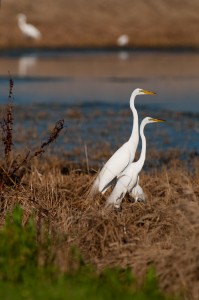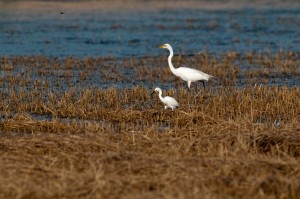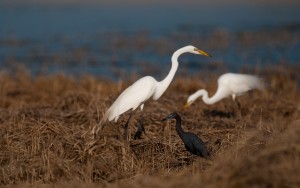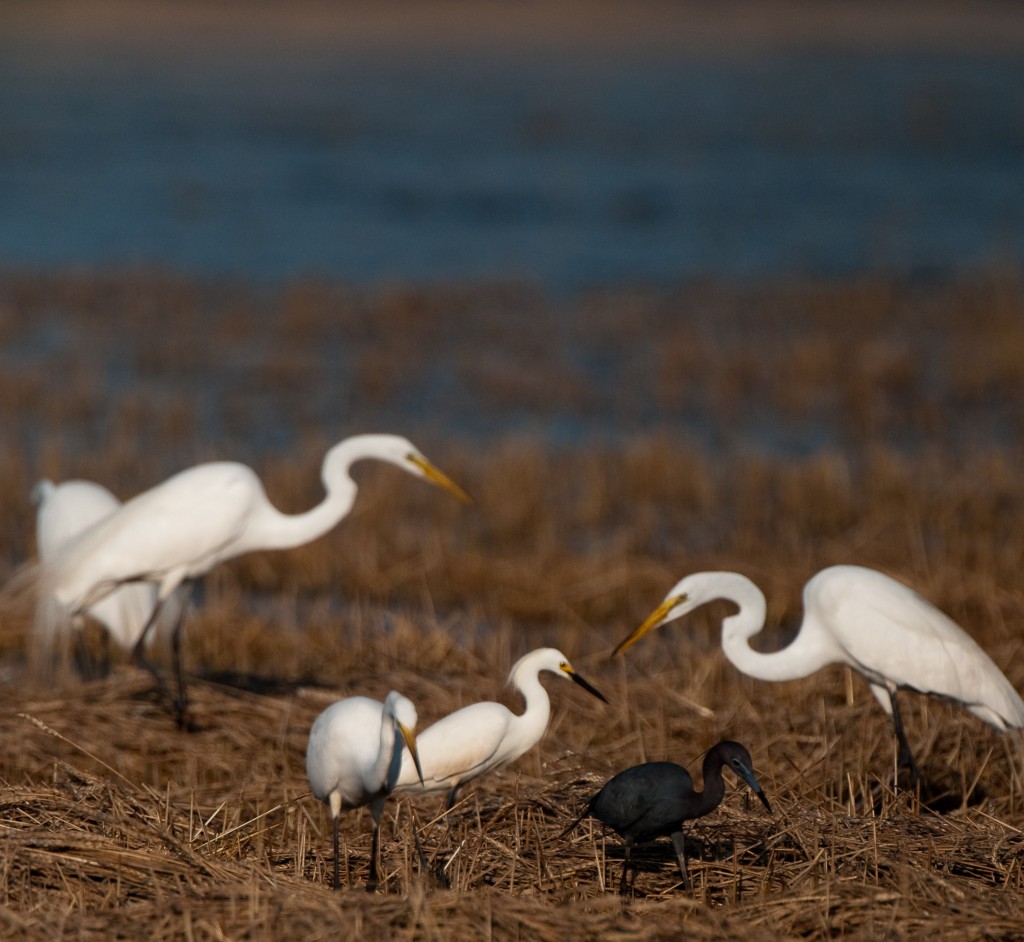The Waders of August
Pools of water along the Mississippi River floodway and bottomlands – pacing summer’s decline with a steadily reducing size – often host large congregations of wading birds. A late-summer leisurely drive along Levee Road offers viewing of hundreds, sometimes thousands, of herons and egrets.
Adult birds, many still sporting worn remnants of once fine nuptial plumage, mingle with juveniles as all spend their time waiting for a meal to swim, hop, or crawl by. The flocks at these pools are mixed in species as well as age grades, as Great Blue Herons, Great Egrets, Snowy Egrets, and Little Blue Herons make common use of these post-breeding season feeding areas.
These four species – sometimes casually called “waders” or, simply, marsh birds, are regular summer residents of our area. Often locally known as “Fish Cranes” and “White Fish Cranes,” herons and egrets are only distantly related to the true cranes. Birds called herons generally have gray-to-blue body plumage and egrets are known by their white feathering; however in the scientific classification scheme, the dark blue Little Blue Heron is more closely related to and so is classified as a member of the genus Egretta.
Herons and egrets have long, fairly slender bodies and long legs and necks. When resting, they often curve their neck into an S shape, often tucking the tip of the bill into breast plumage. When searching for food and hunting, the neck may be fully extended or tucked back. In flight the birds draw their neck back close to their bodies, unlike geese or cranes, which fly with their necks fully out-stretched. All the herons have long, dagger-shaped bills which they skillfully use to capture prey and, when needed, for defense.
By far the largest member of the mixed groups feeding along the Bottoms, Great Blue Herons (Ardea herodias) have blue-gray upperparts, grayish neck, and a long yellow bill. They generally are about four feet in length and have a six- to even seven-foot wing span, and weigh between five to eight pounds. While a few birds may spend the winter foraging at ponds or along streams and rivers with open water, most great blues retreat south for the winter. By late March the main breeding population returns to our area and almost immediately head to their often communal nesting areas, called rookeries.
Rookeries are established in flood plain forest or, more rarely, along streams close to the flood plain. Large, old trees are preferred, and, for great blues, the best real estate is treetops with a nest left over from past years. Males select territories and begin defense displays, initially against both males and females, until finally allowing one female to join him on the nest. Usually four eggs are laid with an incubation time of just under a month. Chicks are cared for and fed by both parents, but after 60 to 90 days of parental care, the pair bond between the adults ends and then, when the youngsters disperse away from the nest site, the entire family bond is broken.
Great Blue Herons often share rookery space with their close relative the Great Egret (Ardea alba), sometimes known as the common egret, American egret, or, rarely now, angel bird. These stately pure-white birds are slightly smaller than Great Blue Herons, with a usual length of just over three feet and a wingspan of slightly more than four feet. Like great blues, Great Egrets have long dagger-like bills, which are bright yellow. During breeding season their pure white feathers are made even showier by long plumes – called aigrettes – growing along the back and which extend beyond the tail. Less cold hardy than great blues, Great Egrets are warm-weather residents of our area, present from early April through October.
These seemingly sociable birds commonly nest among other heron/egret species in floodplain forests, taking the very tops of the tallest trees as first choice if Great Blue Herons are not present to contest this most favored nesting area. Great Egrets also seem to pair bond only for the breeding season, with the entire family bond lasting only until the youngsters are able to leave the nesting area.
The similarly pure white, but smaller, Snowy Egrets often nest in the same rookeries
with Great Blue Herons and Great Egrets. While still closely affiliated to the larger birds, Snowy Egrets (Egretta thula) are members of a different genus. “Snowys” average two feet in length with a wingspread of 41 inches. Their dagger like black bills match their black legs and contrast sharply with their bright yellow feet. Their feet turn even more brightly orange during breeding season, no doubt the source of one of their alternate names: “golden slippers.” Sleekly white at all seasons, breeding Snowy Egrets wear long plumes on their heads and necks and, along their back, sport long, recurved plumes of elegant beauty,
Warm weather residents, snowys migrate to our area in mid to late April and only stay through August. Snowy Egrets have very few known rookeries in Illinois, but after their breeding season, these birds may increase in number in our area as members of more southern colonies disburse as far north as southern Canada. Snowy Egrets often can be sighted amongst the late summer pool gatherers along Levee Road. They are often more active in pursuit of lunch and dinner than nearby Great Blue Herons and Great Egrets, who most often wait and watch for prey. Snowy Egrets often stir up mud and food with foot movements, sometimes even running through shallow water or, more rarely, hover in flight and then drop down to capture prey in water or even on a dry field.
At quick glance, seemingly either an identical twin or, oddly, a reverse image of a Snowy Egret, another species, Little Blue Heron (Egretta caerulea) can be found in late summer at the shallow waters of the American Bottoms. Similar in size, Snowy Egrets and Little Blue Herons are closely related and often will nest in the same colonies. Only one major rookery of Little Blue Herons is known in Southwestern Illinois and the large numbers of juveniles present in our area in late summer very probably disbursed from rookeries further south.
Immature Little Blue Herons are all white, with only the very tips of their outer wing edges colored bluish black. At all ages the legs are dark colored and their bills, pale blue tipped with black, can appear quite dark in dim light. Adult Little Blue Herons live up to their names as their plumage is a deep slate blue. Adolescent birds often appear splotched with a mix of white and blue, as full adult plumage is not gained until the end of their second summer. During breeding season both males and females acquire maroon colored neck feathers accented by slighter longer feathers, gracing the birds with a fringe of hazy reddish accents against the dark blue-gray of their upperparts and wings.
Our ability to spend a late summer afternoon watching and admiring these graceful wading birds is a testament to earlier Americans’ willingness to take action to prevent the extinction of these species. Victims of the dictates of ladies’ fashion, herons and egrets, along with species as diverse as gulls, terns, turkeys, hawks, songbirds and hummingbirds, were slaughtered in the millions for their plumage.
Their feathers adorned women’s hats. Feathers, wing and body parts and, in the case of small songbirds, entire birds, were woven and perched onto hats or made part of a hair style, and also were made into muffs or, occasionally, broach-like decorative accents for lapels and shoulders. The department store O’Neill and Company carried a wide variety of hats in 1884 admired a writer: “Exquisite taste is displayed in the arrangement of wings, heads, and fancy feathers, from the modest little gray and white sea gull to the brilliant bird of Paradise. Plumes are as much in fashion this year as ever.” In 1870 a New York Times writer, even while noting that egret feathers came from birds shot in Florida, since the birds no longer were abundant anywhere else, only lamented that “…the feathers (are) taken to Europe and manufactured into a variety of beautiful millinery articles and returned to us at enormous prices.”
While the Times writer deplored the loss to American milliners’ income, herons and egrets paid the price of fashion. Each plume-adorned hat represented a dozen once-living Great Egrets. The long decorative plumes – the aigrettes – only grow during breeding season. The birds nurseries – their rookeries — turned into charnel houses as plume hunters indiscriminately shot birds on their nests. Newly hatched young herons and egrets that were not killed by the shooting or by the panicked adults were left to starve. The Florida Great Egrets, numbering more than three million in 1880, were all but extinct by 1910. Small relict populations survived at a few privately established refuges.
Audubon Societies, the American Ornithological Union, and early sport/outdoor recreation magazines, such as Forest and Stream agitated for laws to halt the slaughter of birds. Their arguments often brought little more than scorn as statements by Charles Farmer, then Secretary of the Millinery Merchants Protective Association, said in a New York Times letter in 1903, “Fashion demands the aigrette, but we have decided to stop selling it, if that will satisfy the Audubon Society people, though why they should be so interested in a swamp bird which no one but the hunter ever sees, is more than I can understand.”
But the willingness of millinerists to “give up” feathers by no means halted the trade as feathers continued to be exported and reimported to the U.S. Moreover, the slaughter of birds already had moved on to still intact heron and egret rookeries in Central and South America as well as the Caribbean. Even though state and federal regulations protecting birds, particularly plume-bearers, were passed early in the twentieth century, most were either ignored or, perhaps worse, enforced with the most cynical non-punishment and penny-sized fines. Even the sanctuaries established for the beleaguered birds were not safe: in 1905, an Audubon warden of a refuge in Florida was murdered by a plume hunter who later was found not guilty by a local jury. The 1913 Federal Tariff Act and U.S. Congressional legislation known as the Weeks-McLean Act, laid the foundations for the end of the feather trade and the protection of birds in the U.S.
Populations of many heron and egret species still have not fully recovered from decades of slaughter. As population numbers slowly increased through the early twentieth century, declines began again as wetland areas of the southern U.S., particularly Florida and other Gulf Coast states, became prime residential real estate. In our area, once highly productive rookeries along the Mississippi River floodway lost their once towering hardwood trees to the Great Flood of 1993. Today, Snowy Egrets and Little Blue Herons remain on the Illinois endangered species list; while Great Egret and Great Blue Heron populations remain viable, they continue to show small annual population declines. Loss of habitat for both breeding and feeding, particularly for feeding chicks, contributes heavily to the mortality rates for first year birds of all four species and remain between fifty and seventy-five percent.
A late-summer drive along Levee Road, viewing hundreds if not thousands of herons and egrets waiting patiently for a meal, is an enjoyable pastime. But the abundance we seem to see should not blind us, as it did early Americans, to the very finite nature of natural resources and of nature itself.
Clifftop, a local nonprofit organization, is focused on preserving and protecting area bluff lands.
Versions of this article appeared in the August 5 2009 edition of the Suburban Journals Clarion Enterprise and in the August 7 2009 edition of the Monroe County Independent.
© 2009 all content rights reserved, Clifftop NFP.
Comments are currently closed.





